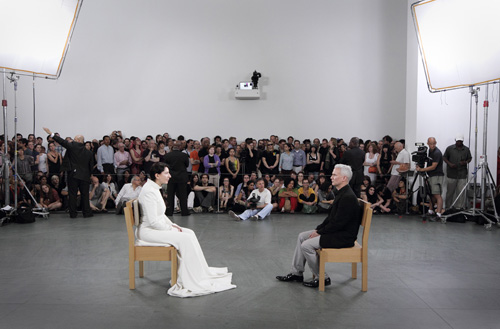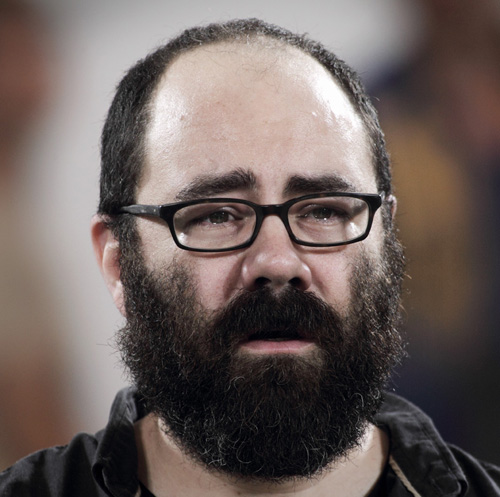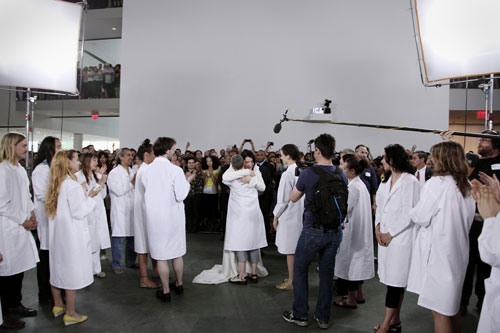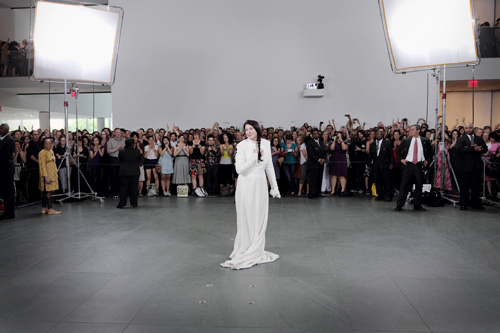James Esber
/
Comments: (0)
Untitled (Starboy), 2009, ink on paper, 23 inches x 16 1/4 inches
And check out this interview from Art Interview with James Esber: >MEGA CLICK HERE<
@HuffingtonPost, 12/23/10 1:05 PM
/
Comments: (0)
 Huffington Post (@HuffingtonPost) Huffington Post (@HuffingtonPost)12/23/10 1:05 PM Shocking video: Man attempts horrifying suicide leap at parliament http://huff.to/g1eO9T |
Sent from Electronic Wizardry.
It's the end...
/
Comments: (0)
What's should I be listening to on these last Septembrial hours?
What have I missed so far?
>BOOM< Shhhhh....
What have I missed so far?
>BOOM< Shhhhh....
Portugal the art
/
Comments: (0)
I was perusing through some of the work in the Portugal Bienniale 2010 and found this:
 |
| Aaron King: Cat Scratch for Stella, 2006 |
I love this sculpture, and I'm not alone.
I used to hate cats, really, I did. But at some point in my life I made peace with the feline species and have embraced their awkwardness, selfishness, egotistical and maniacal ways. I've come to believe that they're really out of this world.
From AIRFORM ARCHIVES [Steve Roden]
Labels:
artist,
blog; sculpture,
installation,
steve roden; sol lewitt; sound
/
Comments: (0)
I came across Steve Roden's blog, Airform Archives the other and was pleased to find his post on Sol Lewitt:

sirs:
-sol lewitt
new york city
More about Steve Roden, his drawings, paintings, installations, sculpture, and my personal favorite - his sound works.
from a letter printed in a 1973 artforum magazine...

sirs:
since 1967 i have been doing folded paper drawings and torn paper drawings. i wanted them to be relatively inexpensive so that they would available to many people. the price was $100 each. some dealers, however, have sold them for more. if anyone has paid more than $100 for one of these drawings, please go back to the dealer from whom it was bought and get a refund for the difference.
-sol lewitt
new york city
More about Steve Roden, his drawings, paintings, installations, sculpture, and my personal favorite - his sound works.
Penimations (2006)
Labels:
Penimations (2006)
/
Comments: (0)
Collaborative video piece with artist Greg Curtis:
Pyramid (2007)
Labels:
Pyramid (2007); tim suzuki
/
Comments: (0)
Pyramid (2007)
Music assisted by Tim Suzuki.
Music assisted by Tim Suzuki.
Intrepidos Punks (2007)
Labels:
Intrepidos Punks (2007)
/
Comments: (0)
This is a mock of what the piece Intrepidos Punks (2007) looked like while in play, as both programs played simultaneously and rise and fall out of sync.
Images of the installation can be found here.
WOMEN VS CHILDREN: LIVE ACTION #03
Labels:
harsh noise; Conceptual Art,
opening
/
Comments: (0)
Our on-going
More info here.
This performance is in conjunction with DAN GRAHAM GALLERY's opening of SUMMER DUDES:
Dan Graham is pleased to announce Summer Dudes a huge group show to kick off the summer. There are oozes, goo-zes, subjective bruises, ink-ies, blink-ies, drippers and flippers coming from these artist's works. We could have called it Psychedelic Sun Burns, Dick Puddles, Sandy Hairs, Non Lazy Sun Bathers or Rip Currents, but the point is these are some great dudes, it's summer, there's a gallery, and a weekend to play.
Come spend some summer times with :
Greg Curtis
Michael Decker
Bradney Evans
Doug Harvey
Brennan Hill
John Hogan
Sanya Kantarovsky
Avram Kosasky
Miles Martinez
Raymond Pettibon
Vincent Ramos
Marcos Siref
Friday June 25th-27th
Opening Friday 7pm
Chicano Activism Captured in Multi-Media Retrospective
/
Comments: (0)
It’s taken 40 years, but organizers hope to tell ‘true story’ of Chicano struggle through films and photos.
By EGP News Report
To commemorate the importance of Chicano activism during the 1960s and 1970s, a special committee formed to mark the 40th anniversary of the Chicano Moratorium will host a reception on June 26 to launch a month-long museum style exhibition of numerous photo collections, films, and memorabilia from the era.
The exhibition will be held at the Mexican Cultural Institute located at Plaza Olvera (Olvera Street) located at 125 Paseo De La Plaza in downtown Los Angeles.
The exhibition will last one month and will showcase special exhibits of art, film, and musical performances each week. An added feature will allow the public to contribute to the event by participating in a commemorative altar for those who died during US wars and military conflicts, as well as surviving veterans.
“The exhibit brings to life again the grass-roots upsurge of Chicano activism of the times, the vibrancy of a unifying movement, the urgency of the burdens of an unjust and unpopular war, anger at the brutal repression of our efforts, and dedication to continue the struggle for social justice and ‘Chicano Power,’” says Rosalío Muñoz, who was the Chair of the August 29, 1970 National Chicano Moratorium Classic, and one of the architects of the current commemoration. “The recently coming-to-light photos, film, audio, and art works, slide shows and collages of news headline clippings help bring out the parallels with the struggles of today for peace, economic justice and defense of our dignity in the face of defamation,” he says.
Munoz serves as the co-chair of the “40th Anniversary Commemoration Committee of the Chicano Moratoriums,” which has organized the multi-media exhibit.
Items featured at the exhibit will include archival material and memorabilia from the collections of activists like former Brown Beret leader Gloria Arellanes, Cal State Northridge Professor Everto Ruiz, USC Professor Felix Gutierrez, Independent Historian Cindy Aragon, and works by Photo Journalists, Victor Alemán, Oscar Castillo, Luis Garza, George Rodriguez, Archivist and Historian Devra Weber, Cinematographer Jesus Salvador Treviño, collections of the East Los Angeles Library Chicano Resource Center, the California State University Los Angeles Special Collections, UCLA Library Los Angeles Times photo collections, and the UCLA Chicano Resource Center.
The public exhibition is one of several events to take place over the next few months to commemorate the Chicano Moratorium. Many of the events planned (some have already been held) are focused on raising awareness about the Chicano Moratorium and its place in Chicano History, says Muñoz.
“So much of our history has been ignored or distorted, our struggles and achievements stereotyped or made invisible. Our youth, immigrant community, public officials don’t know much of our history. Some see our successes as individual, selling our community short. They don’t know about the struggle and sacrifice that was undertaken by people from their own communities to bring about justice, to end the war in Vietnam where young Chicanos were disproportionately losing their lives, and to give future generations more opportunities to succeed,” says Muñoz.
For more information, contact the “40th Anniversary Commemoration Committee of the Chicano Moratoriums” via email at chicano.moratorium@gmail.com, phone (323) 229-1994, or visit their Web site at
http://chicanomoratorium.org/.
***
Found originally here.
By EGP News Report
To commemorate the importance of Chicano activism during the 1960s and 1970s, a special committee formed to mark the 40th anniversary of the Chicano Moratorium will host a reception on June 26 to launch a month-long museum style exhibition of numerous photo collections, films, and memorabilia from the era.
The exhibition will be held at the Mexican Cultural Institute located at Plaza Olvera (Olvera Street) located at 125 Paseo De La Plaza in downtown Los Angeles.
The exhibition will last one month and will showcase special exhibits of art, film, and musical performances each week. An added feature will allow the public to contribute to the event by participating in a commemorative altar for those who died during US wars and military conflicts, as well as surviving veterans.
The Chicano Moratorium against the war in Vietnam drew 30,000 demonstrators on August 29, 1970 in East Los Angeles. (Photos by Oscar Castillo)
“The exhibit brings to life again the grass-roots upsurge of Chicano activism of the times, the vibrancy of a unifying movement, the urgency of the burdens of an unjust and unpopular war, anger at the brutal repression of our efforts, and dedication to continue the struggle for social justice and ‘Chicano Power,’” says Rosalío Muñoz, who was the Chair of the August 29, 1970 National Chicano Moratorium Classic, and one of the architects of the current commemoration. “The recently coming-to-light photos, film, audio, and art works, slide shows and collages of news headline clippings help bring out the parallels with the struggles of today for peace, economic justice and defense of our dignity in the face of defamation,” he says.
Munoz serves as the co-chair of the “40th Anniversary Commemoration Committee of the Chicano Moratoriums,” which has organized the multi-media exhibit.
Items featured at the exhibit will include archival material and memorabilia from the collections of activists like former Brown Beret leader Gloria Arellanes, Cal State Northridge Professor Everto Ruiz, USC Professor Felix Gutierrez, Independent Historian Cindy Aragon, and works by Photo Journalists, Victor Alemán, Oscar Castillo, Luis Garza, George Rodriguez, Archivist and Historian Devra Weber, Cinematographer Jesus Salvador Treviño, collections of the East Los Angeles Library Chicano Resource Center, the California State University Los Angeles Special Collections, UCLA Library Los Angeles Times photo collections, and the UCLA Chicano Resource Center.
The public exhibition is one of several events to take place over the next few months to commemorate the Chicano Moratorium. Many of the events planned (some have already been held) are focused on raising awareness about the Chicano Moratorium and its place in Chicano History, says Muñoz.
“So much of our history has been ignored or distorted, our struggles and achievements stereotyped or made invisible. Our youth, immigrant community, public officials don’t know much of our history. Some see our successes as individual, selling our community short. They don’t know about the struggle and sacrifice that was undertaken by people from their own communities to bring about justice, to end the war in Vietnam where young Chicanos were disproportionately losing their lives, and to give future generations more opportunities to succeed,” says Muñoz.
For more information, contact the “40th Anniversary Commemoration Committee of the Chicano Moratoriums” via email at chicano.moratorium@gmail.com, phone (323) 229-1994, or visit their Web site at
http://chicanomoratorium.org/.
***
Found originally here.
Hands/Insects (2006)
/
Comments: (0)
A blast from the past:
A short work on Super 8 film that was completed in 2006. Images of the film installed and the
sculptures that accompany it can be viewed here.
A short work on Super 8 film that was completed in 2006. Images of the film installed and the
sculptures that accompany it can be viewed here.
All Things Must Come To An End
/
Comments: (0)
Culture Zohn Off the C(H)uff: Marina Abramovic Is Present

Photographs by Marco Anelli
Marina Abramovic finally ended her three-month long marathon The Artist is Present peformance piece at the Museum of Modern Art on Monday. There has been a dinner celebrating her and a symposium which began the debriefing process she considers integral to the work.
There has been much chatter and much written about her solo performance as well as the performers she had engaged to re-perform her work in the exhibition devoted to her in the galleries above. I found the retrospective exhilarating, instructive and alternately high-spirited and heartbreaking. Abramovic takes herself seriously and is undeterred by the naysayers around her. For this quality and her creativity, I have a great deal of admiration.
Abramovic--clearly eager to depart for the countryside and sounding exhausted and emotional--nevertheless took a few minutes to speak with me about her experiences.
CZ: After 700 hours of stillness, even though you did have nights to move around, what was the thing you found most challenging as you completed this piece?
MA: To go back to the normality of life. Because I thought [while it was underway], how I could survive this was with a system of eating and exercises, special things to deal with the pain. There was a system: I go to the MoMA and then I'm in a zone, and I come back afterward. It's been going like this for three months: I started in the winter and finished in the summer. It becomes some kind of system of life--and then breaking this and confronting especially the last day with this audience which has been looking for days in my eyes [over the Memorial Day weekend] and then start talking to them, it was quite a shock. It is very difficult to adjust.I am going to the countryside. Just being in the fresh air, after three months of artificial light! The shock is to go back to normality.
CZ: What was the most frightening moment?MA: It's not something frightening exactly, but really how to deal with the pain which was very extensive especially in April. April was extremely difficult for me because there were five Fridays in April, and ten hours each day. It was really extremely difficult. I really had the fear of how to deal with the pain.CZ: You have trained yourself and the other performers to be able to be able to be still. Yet some of your most original and clearly ground-breaking performance pieces began in repetitive movement. The journey from movement to stillness seems to have culminated in this piece. Has there been a parallel spiritual path?MA: There has been evolution in my work. In the beginning I was very much busy with the physical body and the limits of the physical body but that somehow naturally led me to the mental body and how I could deal with that. Stillness is so much harder, especially for three months. It was a big challenge. As a performer it is the most difficult experience one can have. And the interactive experience with the public made it even harder.CZ: I saw Ulay [Abramovic's former longtime partner in life and work] go up to sit opposite you on opening night. You appeared to be moved. Were you?MA: With Ulay we had long history of living together and being together--twelve years. Finally, we split on the wall in China. We had done a piece where we sat at a table, so this piece was an extension of that--and that was very important. When he came and sat it was a very historical moment--somehow closing the circle and closing one period of my life.CZ: Were there other sitters that you remember vividly or who stood out above the pack who challenged or affected you and why?MA: I looked into something like 1,564 pairs of eyes! It's amazing the memory of these people; they are still stuck in my head, especially anyone who sat longer than 20 minutes. So I created some kind of family with these people. People came back and back, there was a man who came 31 times a woman who came 30 times.
There was a very big man who came once who was like a biker, looking very angry and suspicious. Finally he was looking like a baby, crying, his whole body shaking. It was really a shock with that man how so much pain he had and it was like someone opened the cork of his heart and he had an eruption of emotion that he could not hold in. If you sit in that chair and look at me after a while I am like the mirror of your own self-experience.CZ: The exhibition was an eye-opener on so many levels. People who had never before experienced performance art were literally thrust into understanding the complex feelings and thoughts it can elicit. Though you did not participate upstairs in the exhibition galleries, what was the reaction and feedback you got from your performers? Do you think that with the internet making this imagery available--and now the imprimatur of the Museum of Modern Art--that this might have been a breakthrough to another level of awareness as to the seriousness of performance art as a discipline like painting or sculpture?
MA: It's true that I never got to go upstairs, which is quite incredible! You have to put your ego away and you have to trust these people, you lose control of your own piece. But I believe more than ever that performance art has to be reperformed even if the performer changes the concept because of his own charisma. Still, even though it is different, it is better for it to be performed that way then not to be performed at all. At the symposium it was incredible how articulate and clear the re-performers were, it was quite amazing to listen to their experiences. We will have a book coming out with their experiences, my experience, and the public experiences. It is very important that Marco Anelli, the photographer, spent so much time and energy on a one to one basis, to be present as long as someone occupied that seat facing me.So: the artist is present, the public is present and the photographer is present.CZ: You aim to create an biographical work with Robert Wilson. Will you perform in your own biography or will you cast someone else? What precisely is the nature of the collaboration? And do you envision this work going up in a theater or in a museum. In other words, what kind of art animal is it?MA: The biography has been performed since 1989. Every four or five years I ask a theater director to do my life and I give unconditional control to the director. The directors have the authority to mix my life the way they want. It's the Life and Death of Marina Abramovic with the funeral on the stage. There will be performance artists and me. It will premiere at the Manchester International Festival in July 2011, and then will be touring.
Welcome back, Marina Abramovic!
From the Huffington Post, here.
24 Hour Art People
/
Comments: (0)
Posted at Culture Monster:
Reporting from New York -- L.A.-based conceptual artist Michael Asher is a master of the institutional intervention who has spent his decades-long career devising provocative strategies to challenge the ways that museum-goers experience art.
In 2008 at the Santa Monica Museum of Art at Bergamot Station, for example, he reconstructed the temporary walls from the museum's 44 shows from the previous decade. In 1992, he relocated all the radiators from Switzerland's Kunsthalle Bern to the lobby.
Asher's latest intervention closes out the Whitney Biennial at the Whitney Museum in New York. His concept is to keep the museum open all day and night from Wednesday at midnight through Friday at 11:59 pm, a first for the museum, including pay-what-you-wish hours for after-hours art lovers on a budget.
Asher was unable to travel to New York for the show. “I’m interested in museums and how they function,” Asher said by phone from his home in Los Angeles. “It’s a museum and it closes at regular hours. What would happen if we kept it open?”
The idea was to make it possible for people who normally can’t go to a museum on a weekday to have the chance to do so. “I wanted to democratize the idea of going to a museum a little bit,” Asher said, "so that somebody could go to dinner and then stop by the museum. Or wake up at 3 a.m. and decide not to go back to sleep but maybe to go to the museum and see some art.”
Asher's initial proposal was to keep the Whitney open 24/7 for the duration of the Biennial, a proposal that was scaled back to a week and then to 72 hours, which was as long as the museum could afford to pay union guards and video technicians to keep the museum open.
How is it going, midway through the "intervention"?
“Sometime after midnight on Wednesday there were twentysomethings making the Whitney their last stop for the evening, tourists and even museum members who were hoping to take advantage of the wee hours to have some quality time with the art," says Whitney marketing manager Gretchen Scott.
"I think some people were excited by the novelty of being able to go to the museum late at night, or to say they did it," Scott said. "Some people were familiar with Michael Asher's work but not everyone really understood that it was a piece of art itself."
Whitney Biennial co-curator Gary Carrion-Murayari went to work Wednesday at 6 a.m. -- just in time for an early-morning performance by Aki Sasamoto and to spy some of the some 400 insomniacs and others who showed up starting at midnight, including, he says, a man in a business suit ostensibly on his way to work and a mother with two young children. "I can walk through the museum at 2 a.m. any time I want, I always have that access," Carrion-Murayari said. "For me it was about seeing people who aren't just the young, artsy New York crowd we usually get for the Biennial."
The museum isn't documenting the Asher work in any official way and its effects will be quantified only in the impressions of the visitors who make the effort to haunt the museum in the off-hours.
Asher’s body of work may be high concept, but he says he wasn’t looking to create a spectacle or to influence the viewer’s experience, only to facilitate it.
“Someone who has an art collection can wake up in the middle of the night and go to their living room and look at a painting for awhile,” Asher says. “That is the idea of how close and unmediated I wanted the experience to be. The core of the work is just a reconfiguration of the museum’s hours.
"Many museums would like to see the experience of museum-going democratized but many museums also want to limit the experience," he said. "They have outreach and educational programs where they mediate the experience and change the meaning of it rather than say, 'oh well, this experience is the responsibility of the viewer and they have to work it out themselves.' ”
-- Kristin Hohenadel
Above: Museumgoers at the Whitney Museum at 1 a.m. Thursday. Credit: Whitney Museum.
May 27, 2010
11:39 amReporting from New York -- L.A.-based conceptual artist Michael Asher is a master of the institutional intervention who has spent his decades-long career devising provocative strategies to challenge the ways that museum-goers experience art.
In 2008 at the Santa Monica Museum of Art at Bergamot Station, for example, he reconstructed the temporary walls from the museum's 44 shows from the previous decade. In 1992, he relocated all the radiators from Switzerland's Kunsthalle Bern to the lobby.
Asher's latest intervention closes out the Whitney Biennial at the Whitney Museum in New York. His concept is to keep the museum open all day and night from Wednesday at midnight through Friday at 11:59 pm, a first for the museum, including pay-what-you-wish hours for after-hours art lovers on a budget.
Asher was unable to travel to New York for the show. “I’m interested in museums and how they function,” Asher said by phone from his home in Los Angeles. “It’s a museum and it closes at regular hours. What would happen if we kept it open?”
The idea was to make it possible for people who normally can’t go to a museum on a weekday to have the chance to do so. “I wanted to democratize the idea of going to a museum a little bit,” Asher said, "so that somebody could go to dinner and then stop by the museum. Or wake up at 3 a.m. and decide not to go back to sleep but maybe to go to the museum and see some art.”
Asher's initial proposal was to keep the Whitney open 24/7 for the duration of the Biennial, a proposal that was scaled back to a week and then to 72 hours, which was as long as the museum could afford to pay union guards and video technicians to keep the museum open.
How is it going, midway through the "intervention"?
“Sometime after midnight on Wednesday there were twentysomethings making the Whitney their last stop for the evening, tourists and even museum members who were hoping to take advantage of the wee hours to have some quality time with the art," says Whitney marketing manager Gretchen Scott.
"I think some people were excited by the novelty of being able to go to the museum late at night, or to say they did it," Scott said. "Some people were familiar with Michael Asher's work but not everyone really understood that it was a piece of art itself."
Whitney Biennial co-curator Gary Carrion-Murayari went to work Wednesday at 6 a.m. -- just in time for an early-morning performance by Aki Sasamoto and to spy some of the some 400 insomniacs and others who showed up starting at midnight, including, he says, a man in a business suit ostensibly on his way to work and a mother with two young children. "I can walk through the museum at 2 a.m. any time I want, I always have that access," Carrion-Murayari said. "For me it was about seeing people who aren't just the young, artsy New York crowd we usually get for the Biennial."
The museum isn't documenting the Asher work in any official way and its effects will be quantified only in the impressions of the visitors who make the effort to haunt the museum in the off-hours.
Asher’s body of work may be high concept, but he says he wasn’t looking to create a spectacle or to influence the viewer’s experience, only to facilitate it.
“Someone who has an art collection can wake up in the middle of the night and go to their living room and look at a painting for awhile,” Asher says. “That is the idea of how close and unmediated I wanted the experience to be. The core of the work is just a reconfiguration of the museum’s hours.
"Many museums would like to see the experience of museum-going democratized but many museums also want to limit the experience," he said. "They have outreach and educational programs where they mediate the experience and change the meaning of it rather than say, 'oh well, this experience is the responsibility of the viewer and they have to work it out themselves.' ”
-- Kristin Hohenadel
Ed Ruscha///Hollywood Is A Verb
/
Comments: (0)
 ForYourArt (@ForYourArt) ForYourArt (@ForYourArt)5/25/10 10:41 PM "Hollywood is a Verb" Ed Ruscha http://tinyurl.com/2f5br39 |
Sent with Twitter for iPhone
Diego





































